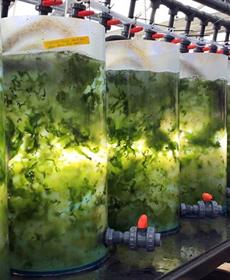|
|
|
|
 |
|
Farmers in the northern Indian region used to rely on snow and glacier meltwater, but the climate crisis is disrupting the water cycle – which means new ways of storing water are needed ...more |
|
|
|
|
|
|
 |
|
Vegetable vendor Shivnarayan Dasana had never seen so many policemen descend on his village in the central Indian state of Madhya Pradesh. ...more |
|
|
|
|
|
|
 |
|
Experts at AccuWeather say extreme weather events and disasters in the past 12 months have had the costliest and most widespread impacts that Americans have faced in nearly a century. ...more |
|
|
|
|
|
|
 |
|
On August 30, 2024, amid the Israeli aggression on Lebanon, Caretaker Prime Minister Najib Mikati announced that Lebanon joined the Saudi-led Middle East Green Initiative (MGI), describing the step as crucial, especially for southern border towns and villages that are suffering significant environmental and agricultural damage. ...more |
|
|
|
|
|
|
 |
|
As the world grapples with the environmental impact of traditional plastics, bioplastics derived from carbon dioxide (CO2) and waste materials present a promising solution. This emerging sustainable market seeks to address two critical global challenges: reducing greenhouse gas emissions and managing waste. By converting CO2 and waste into useful bioplastics, scientists and companies are pioneering technologies that could revolutionize the way we produce and consume plastics. ...more |
|
|
|
|
|
|
 |
|
The protein in sea lettuce, a type of seaweed, is a promising complement to both meat and other current alternative protein sources. Seaweed also contains many other important nutrients, and is grown without needing to be watered, fertilised or sprayed with insecticides. However, the proteins are often tightly bound, and their full potential has not yet been realised on our plates. But now researchers at Chalmers University of Technology, in Sweden, have found a new way to extract these proteins three times more efficiently than before – and this progress paves the way for seaweed burgers and protein smoothies from the sea. ...more |
|
|
|
|
|
|
 |
|
Coventry University is leading a project to reduce plastic, packaging and waste in the British cut-flower industry. ...more |
|
|
|
|
|
|
 |
|
Large expansion of carbon capture and storage is necessary to fulfill the Paris Climate Agreement. Yet a new study led by Chalmers University of Technology, in Sweden and University of Bergen, in Norway, shows that without major efforts, the technology will not expand fast enough to meet the 2°C target and even with major efforts it is unlikely to expand fast enough for the 1.5°C target. ...more |
|
|
|
|
|
|
 |
|
Central Europe's devastating floods were made much worse by climate change and offer a stark glimpse of the future for the world's fastest-warming continent, scientists say. ...more |
|
|
|
|
|
|
 |
|
The world needs trillions of dollars annually to combat climate change, but questions remain as to where that funding will come from. Most at stake are poorer countries that are the least protected — and hardest hit — from the increasing ravages of heat waves, storm surges and other extreme weather events exacerbated each year by climate change. Many of these countries lack the resources to undertake a rapid and just transition to a low-carbon, climate-resilient economy without external help. ...more |
|
|